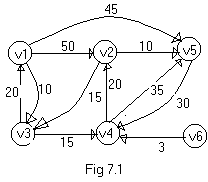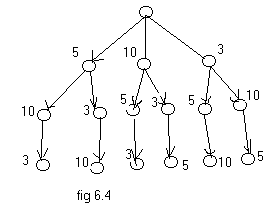7.1 Single-source shortest path:
Graphs can be used to represent the highway structure of a state or
country with vertices representing cities and edges representing
sections of highway. The edges can then be assigned weights which may
be either the distance between the two cities connected by the edge or
the average time to drive along that section of highway. A motorist
wishing to drive from city A to B would be interested in answers to the
following questions:
- Is there a path from A to B?
- If there is more than one path from A to B? Which is the shortest path?
 The
problems defined by these questions are special case of the path
problem we study in this section. The length of a path is now defined
to be the sum of the weights of the edges on that path. The starting
vertex of the path is referred to as the source and the last vertex the
destination.
The graphs are digraphs representing streets. Consider a digraph
G=(V,E), with the distance to be traveled as weights on the edges. The
problem is to determine the shortest path from v0 to all the remaining
vertices of G. It is assumed that all the weights associated with the
edges are positive. The shortest path between v0 and some other node v
is an ordering among a subset of the edges. Hence this problem fits the
ordering paradigm.
Example:
Consider
the digraph of fig 7-1. Let the numbers on the edges be the costs of
travelling along that route. If a person is interested travel from v1
to v2, then he encounters many paths. Some of them are The
problems defined by these questions are special case of the path
problem we study in this section. The length of a path is now defined
to be the sum of the weights of the edges on that path. The starting
vertex of the path is referred to as the source and the last vertex the
destination.
The graphs are digraphs representing streets. Consider a digraph
G=(V,E), with the distance to be traveled as weights on the edges. The
problem is to determine the shortest path from v0 to all the remaining
vertices of G. It is assumed that all the weights associated with the
edges are positive. The shortest path between v0 and some other node v
is an ordering among a subset of the edges. Hence this problem fits the
ordering paradigm.
Example:
Consider
the digraph of fig 7-1. Let the numbers on the edges be the costs of
travelling along that route. If a person is interested travel from v1
to v2, then he encounters many paths. Some of them are
- v1à
v2 = 50 units
- v1à
v3à
v4à
v2 = 10+15+20=45 units
- v1à
v5à
v4à
v2 = 45+30+20= 95 units
- v1à
v3à
v4à
v5à
v4à
v2 = 10+15+35+30+20=110 units
The cheapest path among these is the path along v1à
v3à
v4à
v2. The cost of the path is 10+15+20 = 45 units. Even though there are
three edges on this path, it is cheaper than travelling along the path
connecting v1 and v2 directly i.e., the path v1à
v2 that costs 50 units. One can also notice that, it is not possible to travel to v6 from any other node.
To
formulate a greedy based algorithm to generate the cheapest paths, we
must conceive a multistage solution to the problem and also of an
optimization measure. One possibility is to build the shortest paths
one by one. As an optimization measure we can use the sum of the
lengths of all paths so far generated. For this measure to be
minimized, each individual path must be of minimum length. If we have
already constructed i shortest paths, then using this optimization
measure, the next path to be constructed should be the next shortest
minimum length path. The greedy way to generate these paths in
non-decreasing order of path length. First, a shortest path to the
nearest vertex is generated. Then a shortest path to the second nearest
vertex is generated, and so on.
A much simpler method would be to solve it using matrix representation. The steps that should be followed is as follows,
Step 1: find the adjacency matrix for the given graph. The adjacency matrix for fig 7.1 is given below
|
V1 |
V2 |
V3 |
V4 |
V5 |
V6
|
|
V1 |
- |
50 |
10 |
Inf |
45 |
Inf |
|
V2 |
Inf |
- |
15 |
Inf |
10 |
Inf |
|
V3 |
20 |
Inf |
- |
15 |
inf |
Inf |
|
V4 |
Inf |
20 |
Inf |
- |
35 |
Inf |
|
V5 |
Inf |
Inf |
Inf |
30 |
- |
Inf |
|
V6 |
Inf |
Inf |
Inf |
3 |
Inf |
- |
Step 2: consider v1 to be the source and choose the minimum entry in the row v1. In the above table the minimum in row v1 is 10.
Step
3: find out the column in which the minimum is present, for the above
example it is column v3. Hence, this is the node that has to be next
visited.
Step
4: compute a matrix by eliminating v1 and v3 columns. Initially retain
only row v1. The second row is computed by adding 10 to all values of
row v3.
The resulting matrix is
| |
V2 |
V4 |
V5 |
V6 |
|
V1à
Vw |
50 |
Inf |
45 |
Inf |
|
V1à
V3à
Vw |
10+inf |
10+15 |
10+inf |
10+inf |
|
Minimum |
50 |
25 |
45 |
inf |
Step
5: find the minimum in each column. Now select the minimum from the
resulting row. In the above example the minimum is 25. Repeat step 3
followed by step 4 till all vertices are covered or single column is
left.
The solution for the fig 7.1 can be continued as follows
| |
V2 |
V5 |
V6 |
|
V1à
Vw |
50 |
45 |
Inf |
|
V1à
V3à
V4à
Vw |
25+20 |
25+35 |
25+inf |
|
Minimum |
45 |
45 |
inf |
| |
V5 |
V6 |
|
V1à
Vw |
45 |
Inf |
|
V1à
V3à
V4à
V2à
Vw |
45+10 |
45+inf |
|
Minimum |
45 |
inf |
| |
V6 |
|
V1à
Vw |
Inf |
|
V1à
V3à
V4à
V2à
V5à
Vw |
45+inf |
|
Minimum |
inf |
Finally the cheapest path from v1 to all other vertices is given by V1à
V3à
V4à
V2à
V5.
 click here for more details: click here for more details:
http://www.vyomworld.com/gate/cs/ada/7.1.asp
Post Resume: Click here to Upload your Resume & Apply for Jobs |

 Active Topics
Active Topics  Memberlist
Memberlist  Calendar
Calendar  Search
Search 
 Active Topics
Active Topics  Memberlist
Memberlist  Calendar
Calendar  Search
Search 



 Topic: Single-source shortest path:
Topic: Single-source shortest path: The
problems defined by these questions are special case of the path
problem we study in this section. The length of a path is now defined
to be the sum of the weights of the edges on that path. The starting
vertex of the path is referred to as the source and the last vertex the
destination.
The graphs are digraphs representing streets. Consider a digraph
G=(V,E), with the distance to be traveled as weights on the edges. The
problem is to determine the shortest path from v0 to all the remaining
vertices of G. It is assumed that all the weights associated with the
edges are positive. The shortest path between v0 and some other node v
is an ordering among a subset of the edges. Hence this problem fits the
ordering paradigm.
Example:
Consider
the digraph of fig 7-1. Let the numbers on the edges be the costs of
travelling along that route. If a person is interested travel from v1
to v2, then he encounters many paths. Some of them are
The
problems defined by these questions are special case of the path
problem we study in this section. The length of a path is now defined
to be the sum of the weights of the edges on that path. The starting
vertex of the path is referred to as the source and the last vertex the
destination.
The graphs are digraphs representing streets. Consider a digraph
G=(V,E), with the distance to be traveled as weights on the edges. The
problem is to determine the shortest path from v0 to all the remaining
vertices of G. It is assumed that all the weights associated with the
edges are positive. The shortest path between v0 and some other node v
is an ordering among a subset of the edges. Hence this problem fits the
ordering paradigm.
Example:
Consider
the digraph of fig 7-1. Let the numbers on the edges be the costs of
travelling along that route. If a person is interested travel from v1
to v2, then he encounters many paths. Some of them are
 IP Logged
IP Logged

